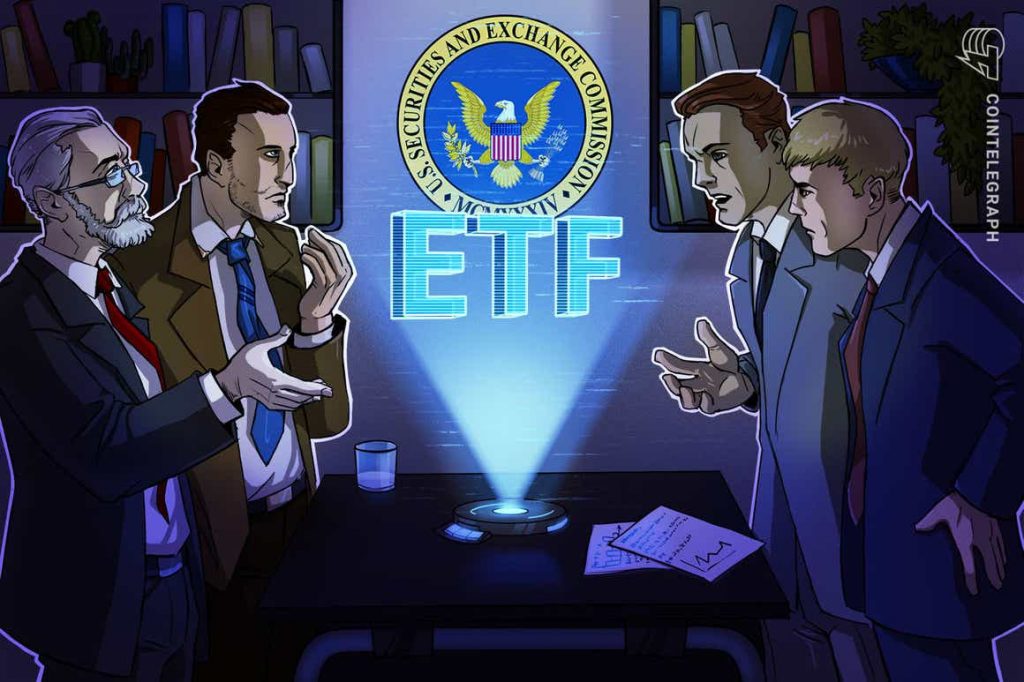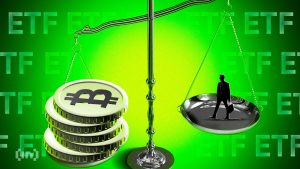VanEck’s Bitcoin spot ETF shunt solidifies SEC’s outlook on crypto

Bitcoin (BTC) has been on an impressive price run since the announcement of the United States Securities and Exchange Commission’s approval of ProShares’ Bitcoin futures exchange-traded fund (ETF) early in October, hitting a new all-time high of over $69,000 on Nov. 10, as per data from TradingView.
However, the financial watchdogs soured the mood by rejecting VanEck’s proposal for a spot ETF on Nov. 12, which acted as a trigger for the price of the flagship cryptocurrency to drop to a 30-day low of $55,705 on Nov. 19. The token is trading in the $56,000 range at the time of writing.
An ETF is a security class that tracks an asset or basket of assets, in this case Bitcoin, and can be traded on a stock exchange like any other stock. Proshares’ BTC ETF was the first ETF to gain approval from the SEC after over 20 applications had been made to the financial regulators in the past.
Jan van Eck, CEO of VanEck, wasn’t happy about the rejection of his company’s ETF.
We are disappointed in today’s update from the SEC declining approval of our physical bitcoin ETF. We believe that investors should be able to gain #BTC exposure through a regulated fund and that a non-futures ETF structure is the superior approach. @tyler @gaborgurbacs
— Jan van Eck (@JanvanEck3) November 12, 2021
The difference between the approved Bitcoin ETFs trading currently across various stock exchanges in the U.S. such as the Nasdaq or CBOE and VanEck’s rejected Bitcoin ETF is that VanEck’s ETF proposal was for a spot ETF, and the approved ETFs are all futures-based ETFs.
Van Eck said that a spot ETF is the better choice, tweeting, “We believe that investors should be able to gain #BTC exposure through a regulated fund and that a non-futures ETF structure is the superior approach.”
SEC Chair Gary Gensler has previously voiced his support for futures-based BTC ETFs instead of price-based. In the official decision to reject VanEck’s ETF application, the SEC said that the product failed to meet the requirement “that the rules of a national securities exchange be ‘designed to prevent fraudulent and manipulative acts and practices’ and ‘to protect investors and the public interest.’”
Futures are often a higher-risk product
However, it could be that financial regulators in the U.S., in rejecting VanEck’s spot ETF, have unleashed a risker product on the same investors it aims to protect, as it allows institutional Wall Street money to leverage Bitcoin’s price movements.
A futures contract gives the holder or buyer of the contract the obligation to purchase the underlying asset and the writer or seller of the contract the obligation to sell and deliver the asset at a specified price on a specified future date unless the holder closes their position prior to the expiration date.
Combined with options, these financial instruments are often used to hedge other positions in the investor’s portfolio or make profits from pure speculation without needing to buy the underlying asset. These markets are usually dominated by institutional investors that have deep pockets to buffer any losses in their portfolio.
Although futures could be used solely to minimize risk in an investor’s profile, where they get riskier is the use of leverage in futures markets. Leverage is the ability to use borrowed funds and/or debt as trading capital in the market to amplify returns from a position. Essentially, it is used by investors to increase their buying power multifold in the markets.
Related: Inflationary winds from around the world spell a sea change for Bitcoin
While leverage also exists in the spot markets, its impact is significantly smaller. However, with futures contracts, the leverage could be up to 95%, which entails that an investor can easily purchase an options contract with 5% of the required capital and borrow the rest. This means any small fluctuations in the price of the underlying asset will have a large impact on the contract, leading to a margin call for investors due to forced liquidations of futures contracts.
A margin call is a scenario wherein the value of the investor’s margins has fallen below the exchange or broker’s required amount. This calls for investors to deposit an amount known as maintenance margin to the account to replenish back to the minimum allowed value. This could also lead to investors having to sell other assets in their portfolios to make up for this amount.
It is important to note that these risks inherent for futures contracts have nothing to do with the nature of the underlying products, but from the methodology by which futures contracts are traded across financial markets. Du Jun, co-founder of cryptocurrency exchange Huobi Global, spoke to Cointelegraph about the SEC’s decision:
“Given the current situation, futures ETFs may be the best choice accepted by the SEC. It’s true that futures ETFs are often complex with a higher risk profile, but the futures ETFs have some characteristics that satisfy the SEC’s demand.”
Jun believes that, to begin with, regulators still haven’t figured out the process to set BTC’s spot price, thus leading them to think that the price is vulnerable to manipulation; so, futures ETFs unlinked to BTC directly would offer investors better protection.
Furthermore, futures ETFs give investors the opportunity to go both long and short on BTC, thus hedging their BTC assets instead of holding units with physically backed BTC.
Antoni Trenchev, co-founder of crypto trading platform Nexo, told Cointelegraph, “The SEC doesn’t seem ready to allow spot ETFs just yet. I have a hunch this will happen in the near-to-mid future, as soon as U.S. regulators are confident in their policies and treatment of Bitcoin and other digital assets.” He said that ultimately, both of these products are just financial tools, and the SEC will want to have a variety of options available.
He noted the SEC’s hesitance to take risks, stating, “They’re simply unwilling to take any risks, which is in itself commendable considering the high pressure from eager investors to have spot ETFs in the U.S.”
However, not all market participants have a positive outlook about the SEC’s approach. Marie Tatibouet, chief marketing officer of crypto exchange Gate.io, told Cointelegraph, “It took the U.S. SEC around four years to figure out how a futures BTC ETF works. It will probably take them two to three years more to figure out spot ETFs.”
Tatibouet said that since BTC futures contracts aren’t linked to the price of Bitcoin directly but to the price of Bitcoin futures, the prices of which are “way easier” to manipulate than spot prices, this could be one of the reasons that the SEC approved futures ETFs.
Canada supports spot ETFs
While the launch of Bitcoin futures ETFs in the U.S. was celebrated by the community as a watershed moment for the cryptocurrency asset class, it was not the first country to allow crypto-related ETFs. The U.S.’ friendly neighbor, Canada, has had Bitcoin ETFs trading on various exchanges for most of this year.
Canada saw the launch of the first Bitcoin ETF in North America, the Purpose Bitcoin ETF, in February this year. This is a physically backed spot Bitcoin ETF that has been successful ever since its launch. Evolve Investments also launched the Evolve Bitcoin ETF soon after, which is also a spot ETF. The Purpose Bitcoin ETFs and the Evolve Bitcoin ETF currently have $1.4 billion and $203 million in assets under management, respectively. The companies behind these ETFs have also gone on to launch Ether (ETH)-based ETFs following the success of their Bitcoin ETFs.
Related: Why now? SEC took eight years to authorize a Bitcoin ETF in the US
Nexos’ Trenchev said, “Canada could be thought of as the El Salvador of Spot BTC ETFs. They’ve been available there for some time now, and things seem to be working out. It’s always an advantage to have examples to look to — regardless of how successful or unsuccessful they are — and I’m certain this will be the case when it comes to spot ETFs in the U.S.”
Jun noted the differences in the legal landscape in the U.S. and Canada, stating, “Canada’s regulatory environment is more flexible, and Canada is more focused on innovation. It often dares to take the lead in financial innovation, like the first modern ETFs in 1990 and the first launch of cannabis ETFs in 2017. But the U.S. market regulatory environment is much stricter.”
Offering a new perspective on the matter, legendary trader Peter Brandt took to Twitter to mention how BTC maximalists should oppose ETFs and spot ETFs completely.
IMO, #Bitcoin maximalists should oppose spot $BTC ETFs in U.S. Bitcoin’s store of value story depends on its scarcity and even some difficulty to purchase. Let’s not encourage greedy grub-hungry Wall Street to convert BTC into a vending machine asset.Say NO to ETFs
— Peter Brandt (@PeterLBrandt) November 13, 2021
It is arguable whether ETFs will support the growth of BTC as an asset in the long term in the way originally intended, and it is undeniable that the developments of crypto ETFs have a large impact on market sentiments and thus, eventually, the price of Bitcoin, which is central to the whole discussion at hand.















